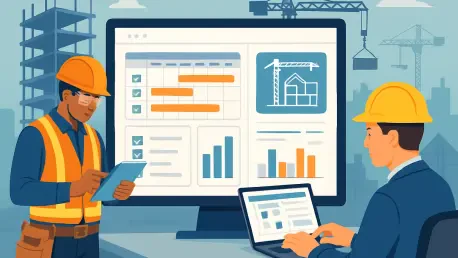In the fast-paced world of construction startups, where projects evolve rapidly and site conditions often throw unexpected challenges, the need for reliable technology partners has never been more critical. Early jobs rarely stick to a neat plan—scopes shift, field crews must communicate from areas with spotty signals, and clients still demand polished dashboards at project handover. Finding a software house that grasps these gritty realities and builds solutions tailored for rugged site environments is essential. From offline data capture to seamless syncing and GPS tagging that works in dead zones, the right partner prioritizes field functionality over flashy boardroom presentations. This decision can make or break a startup’s ability to deliver on time and within budget, ensuring tools integrate with industry standards like Procore or Autodesk Construction Cloud while maintaining safety and compliance. Navigating this choice requires a clear understanding of what to look for and how to test potential collaborators effectively.
1. Prioritizing Field-First Solutions
Construction startups operate in environments where technology must withstand harsh realities, from dusty job sites to unreliable connectivity. A software house worth considering designs for these conditions from the outset, focusing on features like offline data capture that prevents data loss, compressed photo notes with timestamps for quick documentation, and GPS tagging that functions even in signal-dead zones. Beyond functionality, integration with essential construction toolchains such as Procore, Bluebeam, Sage, Autodesk Construction Cloud, and QuickBooks must be planned with defined endpoints and test strategies. Safety and compliance features, including audit trails and role-based access, should be embedded in the initial build, not tacked on later. A partner that understands live job dynamics will also adopt a release rhythm that supports incremental adoption—delivering a punch-list app one week, a reporting view the next, and a subcontractor portal soon after—so crews can adapt without disruption.
Selecting a partner with a field-first mindset also means evaluating their ability to align with the chaotic pace of construction projects. Look for firms that demonstrate a commitment to delivering small, usable features on tight timelines, ensuring that technology evolves alongside active jobs. This approach minimizes downtime and allows for real-time feedback from site teams, fostering tools that truly meet operational needs. Additionally, the best software houses anticipate challenges like scope creep or shifting client demands by embedding flexibility into their development process. They prioritize clear communication with field personnel over impressing office executives, ensuring that solutions remain grounded in practical application. By focusing on these elements, startups can avoid the pitfalls of technology that looks good on paper but fails under the strain of a live construction environment, setting the stage for smoother project execution and client satisfaction.
2. Balancing Product Vision with Engineering Reliability
A hallmark of a strong software partner for construction startups lies in their ability to merge sharp product insight with stable engineering and predictable release cycles. Such firms conduct hands-on discovery workshops to map authentic site workflows, ensuring that the tools reflect real-world needs rather than theoretical ideals. Clickable mockups, testable on mid-range devices commonly used by field crews, become a critical step in validating usability under typical conditions like dust or glare. Moreover, a tech plan that respects both budget constraints and project timelines indicates a partner’s commitment to practicality. The ability to engage effectively with diverse stakeholders—project managers, foremen, finance leads, and tech officers—further ensures that decisions remain rooted in field realities rather than detached presentations, fostering trust across the board.
Beyond initial planning, a reliable software house maintains composure during high-pressure phases like the week before go-live. Edge cases, such as app performance on low battery or weak LTE, are addressed early through testing on the same devices crews carry daily. This proactive approach results in a rollout that feels steady rather than chaotic, with minimal last-minute fixes disrupting operations. Startups benefit from partners who prioritize consistent communication during development, providing updates that reflect progress and challenges transparently. This balance of product vision and technical dependability means that the software evolves as a practical tool, not a source of frustration. By choosing a firm with these traits, construction startups position themselves for smoother launches and long-term scalability, ensuring technology supports rather than hinders their growth in a demanding industry.
3. Identifying Red Flags to Avoid Costly Rework
When evaluating software houses, transparency in delivery processes serves as a critical indicator of reliability for construction startups. Trustworthy partners provide clear estimations, aren’t afraid to push back on unrealistic timelines to protect project integrity, and have a defined playbook for managing scope creep. Requesting a real backlog from a comparable project can reveal much about their approach—look for detailed spikes for unknowns, acceptance criteria mirroring field behaviors, and evidence of risks being resolved rather than glossed over. Observing a design-engineering review can also be telling; the best teams tackle complex API integrations or legacy constraints in real time, revising flows on the spot instead of delaying solutions. This level of openness and problem-solving capacity often separates firms that deliver on promises from those that lead to expensive rework.
Another key area to scrutinize is how a software house handles device compatibility and quality assurance under field conditions. Testing plans should account for older iPhones, mid-range Androids, half-charged batteries, and photos taken in harsh glare—scenarios crews face daily. Quality assurance must be integrated within sprints, conducted on hardware matching what field teams use, to ensure launch readiness. A partner that skims over these details risks delivering tools that falter when it matters most, leading to delays and frustration on active sites. Startups should prioritize firms that demonstrate meticulous care in these areas, as it directly correlates with a rollout crews can trust. Steady updates, clear release notes, and a launch process that feels controlled rather than rushed are the outcomes of such diligence, safeguarding project timelines and budgets from avoidable setbacks.
4. Spotlight on Leading Software Houses
Several software houses stand out for their ability to cater to construction startups with tailored, field-focused solutions. DBB Software excels in delivering quick feature slices and seamless handoffs, specializing in offline capture and intuitive dashboards. Altoros blends product-focused engineering with robust integrations for tools like Procore and Sage, ensuring early value. Vention offers rapid delivery with tight project management, ideal for funded startups navigating scope shifts. Q Agency emphasizes design and consistent release cadences, prioritizing early UX testing for crew input. Experion Technologies provides steady delivery for audit and payment systems, with transparent QA processes. BairesDev brings broad expertise and mature workflows, perfect for MVPs scaling across regions. Simform focuses on testing and adapting based on field feedback, while Vega IT offers collaborative teams that maintain pace. Dualboot Partners combines strategy with build for evolving roles, and Solvd, Inc. ensures quality and stability from day one.
Each of these firms brings unique strengths to the table, addressing specific pain points construction startups face. For instance, startups needing rapid scalability might lean toward BairesDev, while those prioritizing detailed site feedback could find Vega IT’s adaptability a better fit. The diversity in focus—whether on design, integration, or quality—means there’s likely a partner suited to varying project needs and budget constraints. Evaluating these options requires aligning their expertise with specific operational challenges, such as device coverage or compliance demands. Startups benefit from shortlisting a few based on initial research, then diving deeper into their past projects and client testimonials. This approach helps uncover which software house can truly deliver under the unique pressures of construction environments, ensuring technology becomes an asset rather than a liability on the job site.
5. Running a Two-Week Test Sprint for Evaluation
Before committing to a long-term partnership, conducting a two-week test sprint offers a practical way to assess a software house’s capabilities. Start by selecting a core workflow that spans field to office, such as punch-list capture through client sign-off. In days 1–2, map out form fields, photo tags, user roles (foreman, subcontractor, client), and error states using clear, crew-friendly language. During days 3–5, review clickable mockups on real phones, refining labels, units, and edge cases to eliminate confusion. From days 6–10, expect a functional mini-app with offline capabilities, photo compression, and a web view sorted by trade and location. Finally, in days 11–14, trial the app on two active jobs, noting where users slow down and how swiftly issues are resolved, ensuring the tool holds up under real project pressures.
To further stress-test the software house’s responsiveness, simulate harsh field conditions during the trial. Evaluate the app under weak connectivity, bright sunlight, tight spaces, and while wearing gloves, tasking crews to take numerous rapid photos, mark items, and sync from remote areas like parking lots. Verify that timestamps, locations, and usernames remain intact even after challenges like a dead battery. Fixes for any rough edges should land within the sprint, demonstrating the partner’s agility. This rigorous testing not only highlights technical proficiency but also reveals how well the firm adapts to feedback and prioritizes user experience in challenging environments. A team that passes this evaluation shows readiness to support a construction startup’s dynamic needs, providing confidence in their ability to deliver reliable solutions when full-scale development begins.
6. Navigating Budget, Ownership, and Seamless Handoffs
Budget considerations play a pivotal role in selecting a software partner for construction startups, requiring a detailed comparison of pricing models. Evaluate costs across full scope, trimmed scope, and core-only options, analyzing how features shift between tiers and the rationale behind those decisions. Look for savings that don’t compromise outcomes, such as leveraging native device cameras, reusing existing chart libraries, or delaying heavy integrations to later phases while still delivering immediate value. This approach ensures financial resources are allocated efficiently, supporting project milestones without unnecessary expenditure. A transparent partner will break down hours and timelines clearly, allowing startups to make informed choices that balance cost with functionality, ultimately protecting the bottom line during critical early growth stages.
Ownership terms and handover processes are equally vital to long-term success. Secure a repository that internal staff can manage, documentation accessible to new hires, and infrastructure costs sustainable beyond the initial contract. Clarify in writing how change orders, warranty fixes, and incident responses are handled, with enforceable response times to avoid delays. Plan the handoff like a project closeout—admin screens should enable independent management of trades, crews, and cost codes without vendor intervention. Training must be concise and repeatable, ideally with short guides foremen can access on their phones. A software house that addresses these checkpoints with clarity and consistent updates demonstrates alignment with how construction startups scale—building lean, learning fast, and keeping sites operational while technology integrates seamlessly into daily workflows.
7. Reflecting on the Path to Partnership Success
Looking back, the journey to finding the right software house for a construction startup demanded a focus on field-ready solutions, transparent processes, and rigorous testing. Partners who prioritized offline functionality, seamless integrations, and incremental releases proved their worth in the chaos of live projects. Test sprints revealed which firms could adapt under pressure, delivering tools that held up in harsh conditions while maintaining clear communication. Budget evaluations and ownership agreements further solidified trust, ensuring startups retained control over their technology long after initial development wrapped up.
Moving forward, the next steps involve leveraging these insights to finalize a partnership that supports scalable growth. Startups should commit to ongoing collaboration with the chosen firm, refining tools based on evolving site needs and client expectations. Establishing regular check-ins for feedback and updates will maintain alignment, while planning for future integrations can keep technology ahead of industry demands. By building on the foundation of a carefully vetted partner, construction startups can transform technology from a challenge into a competitive edge, driving efficiency and success across every project.









